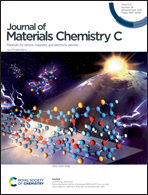Recent development of heavy-atom-free triplet photosensitizers: molecular structure design, photophysics and application
Abstract
Triplet photosensitizers (PSs) have attracted much attention in recent years, due to the significance of these kinds of compounds in fundamental photochemistry studies and applications in photocatalysis, photodynamic therapy (PDT) and triplet–triplet-annihilation upconversion (TTA-UC). Heavy-atom-free triplet PSs are of particular interest, because of the advantages of low cost, low toxicity and long-lived triplet states compared with triplet PSs that rely on the heavy-atom effect to enhance intersystem crossing (ISC). This review article summarizes recent developments in the design and application of heavy-atom-free triplet PSs, including those based on compact orthogonal electron donor–acceptor dyads, or compounds with twisted π-conjugation frameworks, or those that contain thiocarbonyl groups. The ISC mechanisms of these different types of triplet PSs are discussed, and all are based on enhanced spin–orbit coupling. Moreover, the electron spin selectivity of ISC, studied via time-resolved electron paramagnetic resonance (TREPR) spectra, is also introduced. Some new discoveries and the challenges in this area are discussed, for instance, the role of the triplet charge-transfer (3CT) state in the spin–orbit charge-transfer ISC (SOCT-ISC) mechanism, the relationship between the twisted π-conjugation frameworks and the ISC efficiency, and determination of the intrinsic triplet-state lifetimes.



 Please wait while we load your content...
Please wait while we load your content...